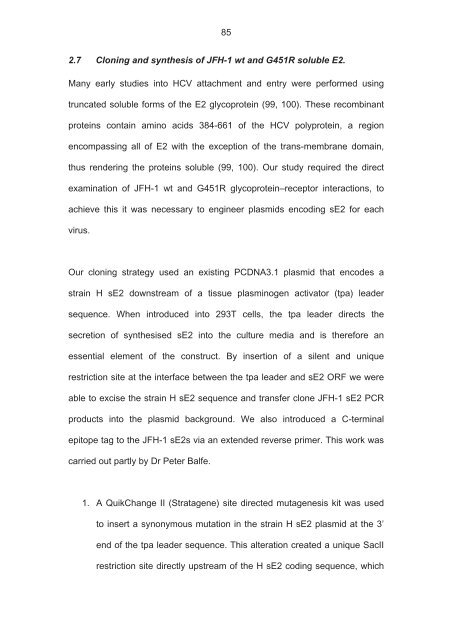The role of scavenger receptor BI in hepatitis - eTheses Repository ...
The role of scavenger receptor BI in hepatitis - eTheses Repository ...
The role of scavenger receptor BI in hepatitis - eTheses Repository ...
Create successful ePaper yourself
Turn your PDF publications into a flip-book with our unique Google optimized e-Paper software.
2.7 Clon<strong>in</strong>g and synthesis <strong>of</strong> JFH-1 wt and G451R soluble E2.<br />
85<br />
Many early studies <strong>in</strong>to HCV attachment and entry were performed us<strong>in</strong>g<br />
truncated soluble forms <strong>of</strong> the E2 glycoprote<strong>in</strong> (99, 100). <strong>The</strong>se recomb<strong>in</strong>ant<br />
prote<strong>in</strong>s conta<strong>in</strong> am<strong>in</strong>o acids 384-661 <strong>of</strong> the HCV polyprote<strong>in</strong>, a region<br />
encompass<strong>in</strong>g all <strong>of</strong> E2 with the exception <strong>of</strong> the trans-membrane doma<strong>in</strong>,<br />
thus render<strong>in</strong>g the prote<strong>in</strong>s soluble (99, 100). Our study required the direct<br />
exam<strong>in</strong>ation <strong>of</strong> JFH-1 wt and G451R glycoprote<strong>in</strong>–<strong>receptor</strong> <strong>in</strong>teractions, to<br />
achieve this it was necessary to eng<strong>in</strong>eer plasmids encod<strong>in</strong>g sE2 for each<br />
virus.<br />
Our clon<strong>in</strong>g strategy used an exist<strong>in</strong>g PCDNA3.1 plasmid that encodes a<br />
stra<strong>in</strong> H sE2 downstream <strong>of</strong> a tissue plasm<strong>in</strong>ogen activator (tpa) leader<br />
sequence. When <strong>in</strong>troduced <strong>in</strong>to 293T cells, the tpa leader directs the<br />
secretion <strong>of</strong> synthesised sE2 <strong>in</strong>to the culture media and is therefore an<br />
essential element <strong>of</strong> the construct. By <strong>in</strong>sertion <strong>of</strong> a silent and unique<br />
restriction site at the <strong>in</strong>terface between the tpa leader and sE2 ORF we were<br />
able to excise the stra<strong>in</strong> H sE2 sequence and transfer clone JFH-1 sE2 PCR<br />
products <strong>in</strong>to the plasmid background. We also <strong>in</strong>troduced a C-term<strong>in</strong>al<br />
epitope tag to the JFH-1 sE2s via an extended reverse primer. This work was<br />
carried out partly by Dr Peter Balfe.<br />
1. A QuikChange II (Stratagene) site directed mutagenesis kit was used<br />
to <strong>in</strong>sert a synonymous mutation <strong>in</strong> the stra<strong>in</strong> H sE2 plasmid at the 3’<br />
end <strong>of</strong> the tpa leader sequence. This alteration created a unique SacII<br />
restriction site directly upstream <strong>of</strong> the H sE2 cod<strong>in</strong>g sequence, which

















